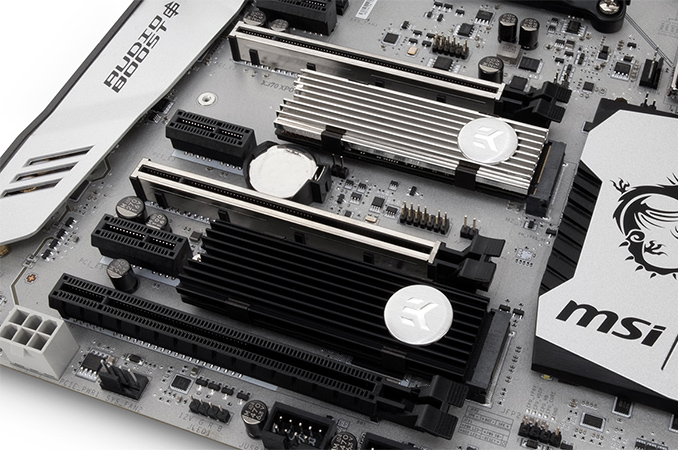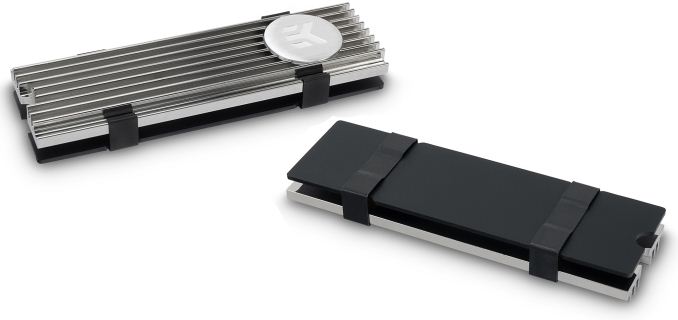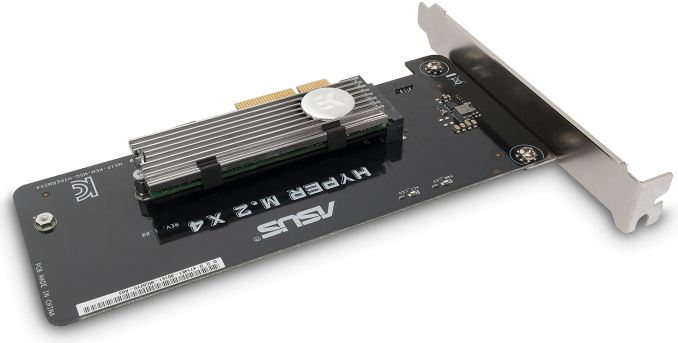EKWB Launches Aftermarket EK-M.2 Aluminum Heatsink for M.2 SSDs
by Anton Shilov on July 6, 2017 2:00 PM EST- Posted in
- Cases/Cooling/PSUs
- SSDs
- cooling
- M.2
- EKWB

EKWB (EK Water Blocks) on Wednesday introduced a useful but slightly different to their normal routine type of product. The company has started to sell its EK-M.2 NVMe passive heatsinks, designed for consumer M.2 SSDs that matches the design of the company’s water blocks and other components. The device costs €10 – €13, depending on the finish.
Advantages of M.2 SSDs over consumer drive form-factor drives have been discussed multiple times before: they are smaller, sometimes they are cheaper to make, and they are faster because they use PCIe interface along with NVMe protocol (in most cases). However, they have one main drawback that sometimes affects their performance: they are hard to cool down. Contemporary SSD controllers contain multiple computing cores and perform rather intensive mathematical operations in order to work with modern NAND flash memory properly and correct read errors that occur with the latest types of flash (and thus guarantee their endurance rating). As a result, sometimes those controllers overheat on M.2 drives because of insufficient cooling and begin to throttle, reducing performance. Going forward, SSD controllers will become even more complex, especially as the industry moves to higher bit densities with TLC and then QLC architectures. Developers of such controllers will likely try to keep their TDPs in check by using lower-power compute cores and/or low-power process technologies, but it remains to be seen whether temperatures of next-gen controllers will be lower than temperatures of modern ones.
Various industry players attempt to ensure proper cooling of M.2 SSDs by equipping their drives with thermal pads (Samsung) or heatsinks (Plextor), offering heatsinks with motherboards (MSI) or selling aftermarket thermal pads (Silverstone). Now, EK Water Blocks is throwing its 2c and offering aftermarket M.2 heatsinks for owners of its LCS and other customers.
The EK-M.2 NVMe passive heatsinks are made of aluminum, feature front and back plates, and are equipped with clips to attach them to SSDs. The coolers are compatible with single-sided M.2-2280 drives plugged into M.2 slots that are of 4.2 mm height. Essentially, EK-M.2 NVMe can handle standard consumer SSDs installed into typical desktop motherboards, but compatibility beyond that cannot be guaranteed. According to EKWB, the EK-M.2 heatsink can reduce controller temperature by 8-10°C, or even more with appropriate airflow.
As for pricing, EKWB sells its the EK-M.2 NVMe heatsink with black finish for €9.96, whereas the M.2 SSD cooler with nickel finish costs €12.94 (incl. VAT). The products are available from EKWB’s online store as well as from its resellers.
Related Reading:
- EK Water Blocks Announces Aluminum-based Fluid Gaming Series Open Loop Liquid Coolers
- SilverStone Launches SST-TP01-M.2 Thermal Pads for M.2 SSDs
- Intel Announces SSD DC P4501 Low-Power NVMe SSD With 3D NAND
- Plextor Announces M9Pe SSD: 3.1 GB/s, Marvell Controller, 64-Layer 3D TLC, RGB LEDs
- Patriot Preps Budget-Priced & Phison-Based Scorch NVMe SSD For Q3
- Toshiba Introduces XG5 Client NVMe SSD
Source: EKWB


















24 Comments
View All Comments
willis936 - Thursday, July 6, 2017 - link
I'm really disappointed that this isn't a line of products to watercool SSDs.meacupla - Friday, July 7, 2017 - link
at first, I thought EK must be crazy, releasing an aluminum block for M.2 SSDs, but then I saw it was a sensible air cooled aluminum heatsink.Why would you want a water cooled M.2 block anyways? How is that even going to fit between video cards?
satai - Thursday, July 6, 2017 - link
To rebenchmark 960 EVO with such a cooler could be interesting...Bullwinkle J Moose - Thursday, July 6, 2017 - link
Anodized Aluminum does not transfer heat wellClean bare Aluminum is great until it grows an oxide skin
Bead blasted clean bare aluminum is even better due to the increased surface area
The bottom of many cheap heat sinks is not perfectly flat AND is also anodized
To transfer heat from the SSD to the sink as fast as possible, you can use a medium grit wet/dry paper on a flat table top and remove the anodized finish from the bottom of the heat sink
I take photos of the bottom as the anodized finish is being removed if I see that it is not really flat for future reference and temp measurements before and after the the sinks are lapped
If the bottom is not really flat, you may only have a few tiny contact points on the flash memory to transfer the heat
Many thincoat metal treatments are available to prevent oxidation if you choose to beadblast the top surface and work much better than anodization
Stock coolers may look pretty but you won't win any races!
Lord of the Bored - Monday, July 10, 2017 - link
"Stock coolers may look pretty but you won't win any races!"What is stock about this cooler?
Bullwinkle J Moose - Thursday, July 6, 2017 - link
The mods listed above work best on "Silent" computers without a fanIf you are using a fan to remove heat, a copper sheet is probably all you really need
Thermal transfer paste should be the best you can get at a reasonable price
A 1 degree difference between the best thermal paste and the second best can be a $20 difference in price
I'll take second best if that's the case
cfenton - Friday, July 7, 2017 - link
This probably makes me a sucker, but I might buy one of these just because they look good. I have a 960 EVO and it really sticks out on my motherboard. For this price, if it helps cool the drive down that's great, but I'd probably be happy as long as it doesn't hurt performance.Beaver M. - Saturday, July 8, 2017 - link
Im skeptical. I made heatsinks myself for a few M.2 SSDs and the hottest thing on there isnt the NAND, its the controller chip. It can and will get up to 100C hot, but is often seated a bit higher or lower than the NAND, which makes using an uniformly heatsink like this kinda useless, because it wont sit properly.Also a fun fact: The temperature diode, which shows the temperature in monitoring software is located between the NAND and controller. So it will never show how hot the controller will really get. Or the NANDs real temperature, for that matter. In most cases, when the diode showed 60-70C degrees, the controller temperature was 90-100C and the NANDs around 50.
Beaver M. - Saturday, July 8, 2017 - link
Also if they say it will only reduce controller temperature by 8-10C, that is not very good. I only placed a aluminum heatsink only a little bigger than the controller on it and it went down 20C. Placed a small fan above it and it went down another 15-20.ads295 - Monday, July 10, 2017 - link
Very interesting. How did you mount the heatsink and fan onto the controller? What was the size of the fan? Must've been tiny.